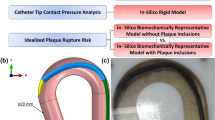Abstract
Abdominal aortic aneurysms occur in as much as 2–3% of the population, and their rupture produces a mortality rate of 78–94% (1), causing 15,000 deaths per year in the U.S. alone. As an investigation into the mechanical factors that lead to aneurysm rupture, flow field measurements are presented for steady flow through a range of aneurysm sizes and Reynolds numbers. Seven rigid symmetric models of aneurysms were constructed with uniform lengths of 4d and diameters that ranged from 1.4 to 3.3d, whered is the inner diameter of the undilated entrance tube. Color Doppler flow imaging was used to visualize the flow fields, while laser Doppler velocimetry was used to quantify the flow field velocities and to determine critical Reynolds numbers for the onset of, and complete transition to, turbulent flow. Estimates of mean and peak wall shear stresses were derived from velocity measurements. Flow in these models varied from fully laminar to fully turbulent over the range of Reynolds numbers corresponding toin vivo flows. There was a large range over which the flow was intermittently turbulent. High wall shear occurred in the models when the flow was turbulent, suggesting that turbulence inin vivo aneurysms may contribute significantly to their risk of rupture.
Similar content being viewed by others
References
Bernstein, E. F., R. B. Dilley, L. E. Goldberger, B. B. Gosink, and G. R. Leopold. Growth rates of small abdominal aortic aneurysms.Surgery 80:765–773, 1976.
Bluth, E. I., S. M. Murphey, L. H. Hollier, and M. A. Sullivan. Color flow Doppler in the evaluation of aortic aneurysms.Int. Angiol. 9:8–10, 1990.
Budwig, R., D. Elger, H. Hooper, and J. Slippy. Steady flow in abdominal aortic aneurysm models.J. Biomech. Eng. 115:418–423, 1993.
Dalen, J. E. Diseases of the Aorta. In: Principals of Internal Medicine, edited by K. J. Isselbacker, R. D. Adams, E. Braunwald, R. G. Petersdorf, and J. D. Wilson, New York: McGraw-Hill, pp. 1178–1181, 1980.
Darling, R. C. Ruptured arteriosclerotic abdominal aortic aneurysms: a pathologic and clinical study.Am. J. Surg. 119:397–401, 1970.
Darling, R. C., C. R. Messina, and D. C. Brewster. Autopsy study of unoperated abdominal aortic aneurysms. The case for early resection.Circulation 56 (Suppl. 2):161–165, 1977.
Fox, R. W., and A. T. McDonald. Introduction to Fluid Mechanics, 4th ed. New York: Wiley, pp. 348–353, 1985.
Fung, Y.-C. Biomechanics: Mechanical Properties of Living Tissue. New York: Springer-Verlag, pp. 62–71, 1981.
Johansen, K. Aneurysms.Sci. Am. 247:110–122, 1982.
Louridas, G., K. Reilly, and M. O. Perry. The role of the aortic aneurysm diameter aortic diameter ratio in predicting the risk of rupture.S. Afr. Med. J. 78:642–643, 1990.
Maier, S. E., D. Meier, P. Boesiger, U. T. Moser, and A. Vieli. Human abdominal aorta: comparative measurements of blood flow with MR imaging and multigated Doppler US.Radiology 171:487–492, 1989.
Nevitt, M. P., D. J. Ballard, and J. W. Hallet. Prognosis of abdominal aortic aneurysms, a population based study.N. Engl. J. Med. 321:1009–1014, 1989.
Quill, D. S., M. P. Colgan, and D. S. Sumner. Ultrasonic screening for the detection of abdominal aortic aneurysms.Surg. Clin. N. Am. 69:713–720, 1989.
Peattie, R. A., T. Schrader, E. I. Bluth, and C. E. Comstock. Development of turbulence in steady flow throuth models of abdominal aortic aneurysms.J. Ultrasound Med. 13:467–472, 1994.
Perktold, K. On the paths of fluid particles in an axisymmetrical aneurysm.J. Biomech. 20:311–317, 1987.
Reilly, J. M., and M. D. Tilson. Incidence and etiology of abdominal aortic aneurysms.Surg. Clin. N. Amer. 69:707–711, 1989.
Scherer, P. W. Flow in axisymmetric glass model aneurysms.J. Biomech. 6:695–700, 1973.
Schrader, T., R. A. Peattie, E. I. Bluth, and C. E. Comstock. A qualitative investigation of turbulence in the flow through a model of an abdominal aortic aneurysm.Invest. Radiol. 27:515–519, 1992.
Tam, M. K., J. Melbin, and D. H. Knight. Hemodynamic phenomena in fusiform aneurysms—I: Steady flow conditions.IEEE Trans. Biomed. Eng. BME-23:453–459, 1976.
Wille, S. O. Pulsatile pressure and flow in an arterial aneurysm simulated in a mathematical model.J. Biomed. Eng. 3:153–158, 1981.
Author information
Authors and Affiliations
Rights and permissions
About this article
Cite this article
Asbury, C.L., Ruberti, J.W., Bluth, E.I. et al. Experimental investigation of steady flow in rigid models of abdominal aortic aneurysms. Ann Biomed Eng 23, 29–39 (1995). https://doi.org/10.1007/BF02368298
Received:
Revised:
Accepted:
Issue Date:
DOI: https://doi.org/10.1007/BF02368298




